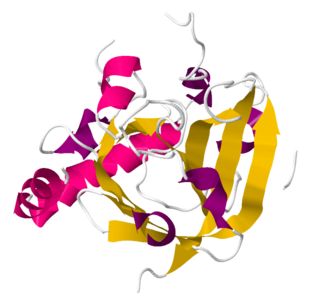Related Research Articles

A pilus is a hair-like appendage found on the surface of many bacteria and archaea. The terms pilus and fimbria can be used interchangeably, although some researchers reserve the term pilus for the appendage required for bacterial conjugation. All pili in the latter sense are primarily composed of pilin proteins, which are oligomeric.

Moraxella catarrhalis is a fastidious, nonmotile, Gram-negative, aerobic, oxidase-positive diplococcus that can cause infections of the respiratory system, middle ear, eye, central nervous system, and joints of humans. It causes the infection of the host cell by sticking to the host cell using trimeric autotransporter adhesins.

A diplococcus is a round bacterium that typically occurs in the form of two joined cells.
Pilin refers to a class of fibrous proteins that are found in pilus structures in bacteria. These structures can be used for the exchange of genetic material, or as a cell adhesion mechanism. Although not all bacteria have pili or fimbriae, bacterial pathogens often use their fimbriae to attach to host cells. In Gram-negative bacteria, where pili are more common, individual pilin molecules are linked by noncovalent protein-protein interactions, while Gram-positive bacteria often have polymerized LPXTG pilin.
Moraxella is a genus of gram-negative bacteria in the family Moraxellaceae. It is named after the Swiss ophthalmologist Victor Morax. The organisms are short rods, coccobacilli, or as in the case of Moraxella catarrhalis, diplococci in morphology, with asaccharolytic, oxidase-positive, and catalase-positive properties. M. catarrhalis is the clinically most important species under this genus.

Sulfolobaceae are a family of the Sulfolobales belonging to the domain Archaea. The family consists of several genera adapted to survive environmental niches with extreme temperature and low pH conditions.

Sortase refers to a group of prokaryotic enzymes that modify surface proteins by recognizing and cleaving a carboxyl-terminal sorting signal. For most substrates of sortase enzymes, the recognition signal consists of the motif LPXTG (Leu-Pro-any-Thr-Gly), then a highly hydrophobic transmembrane sequence, followed by a cluster of basic residues such as arginine. Cleavage occurs between the Thr and Gly, with transient attachment through the Thr residue to the active site Cys residue, followed by transpeptidation that attaches the protein covalently to cell wall components. Sortases occur in almost all Gram-positive bacteria and the occasional Gram-negative bacterium or Archaea, where cell wall LPXTG-mediated decoration has not been reported. Although sortase A, the "housekeeping" sortase, typically acts on many protein targets, other forms of sortase recognize variant forms of the cleavage motif, or catalyze the assembly of pilins into pili.
Moraxella osloensis is a Gram-negative oxidase-positive, aerobic bacterium within the family Moraxellaceae in the gamma subdivision of the purple bacteria.
Suttonella indologenes, formerly Kingella indologenes, is a Gram-negative rod-shaped bacterium of the family Cardiobacteriaceae. Like other members of its family, it is a bacterium that is assumed to be normally present in the respiratory tract. It has been found to rarely cause endocarditis, an infection of the heart valves. It also been found in the eye. It may cause eye infections. Little is known about it as a bacterium other than its structure and biochemical composition. Like other members in its family, it has a characteristic 16S ribosomal RNA which consists of 1474 base pairs.
Oligella urethralis is a Gram-negative, oxidase-positive, nonfermentative bacterium of the genus Oligella which can cause urosepsis.
Moraxella atlantae is a Gram-negative, oxidase-positive and catalase-positive, rod-shaped, nonmotile bacterium in the genus Moraxella, which was isolated from aerobic blood cultures from a female cancer patient. M. atlantae is a rare opportunistic pathogen which can usually be treated by common antibiotics.
Moraxella boevrei is a Gram-negative, oxidase- and catalase-positive, aerobic nonmotile bacterium in the genus Moraxella, which was isolated from the nasal flora of healthy goats in Lyon in France.
Moraxella canis is a Gram-negative, oxidase-positive bacterium in the genus Moraxella, which was isolated from a wound from dog bite in Sweden and from an ulcerated supraclavicular lymph node of a patient.
Moraxella caprae is a Gram-negative, aerobic, nonmotile bacterium in the genus Moraxella, which was isolated from the nasal flora of goats in Lyon in France.
Moraxella lincolnii is a Gram-negative bacterium in the genus Moraxella, which was isolated from the human respiratory tract.
Moraxella oblonga is a catalase- and oxidase-positive, Gram-negative bacterium in the genus Moraxella, which was isolated from the oral cavity of a sheep. Alysiella sp. was transferred to M. oblonga.
Moraxella bovoculi is a Gram-negative bacterium in the genus Moraxella, which was isolated from the eyes of calves in Browns Valley, California. M. bovoculi can cause infectious bovine keratoconjunctivitis.
Moraxella pluranimalium is a Gram-negative, aerobic, catalase- and oxidase-positive, non-spore-forming bacterium in the genus Moraxella, which was isolated from the nasal turbinate of a pig.
Moraxella porci is a Gram-negative, aerobic, catalase- and oxidase-positive, non-endospore-forming bacterium in the genus Moraxella, which was isolated from the brain of a pig suffering from meningitis.
Sphingomonas melonis is a bacterium from the genus of Sphingomonas which has been isolated from the plant Cucumis melo var. inodorus in Madrid in Spain. Sphingomonas melonis can cause brown spots on melon fruits from the melon plant.
References
- ↑ LPSN lpsn.dsmz.de
- ↑ Straininfo of Moraxella nonliquefaciens
- ↑ Taxonomy Browser
- 1 2 The type 4 pilin of Moraxella nonliquefaciens exhibits unique similarities with the pilins of Neisseria gonorrhoeae and Dichelobacter (Bacteroides) nodosus Journal of General Microbiology (1991), 137, 2483-2490.
- ↑ Laukeland, H.; Bergh, K.; Bevanger, L. (2002). "Posttrabeculectomy Endophthalmitis Caused by Moraxella nonliquefaciens". Journal of Clinical Microbiology. 40 (7): 2668. doi:10.1128/JCM.40.7.2668-2670.2002. PMC 120585 . PMID 12089304.
- ↑ Martin Dworkin; Stanley Falkow; Eugene Rosenberg; Karl-Heinz Schleifer; Erko Stackebrandt (2006-09-28). The Prokaryotes: Vol. 6: Proteobacteria: Gamma Subclass: A Handbook on the Biology of Bacteria (3 ed.). Springer. ISBN 038725496X.
- ↑ UniProt